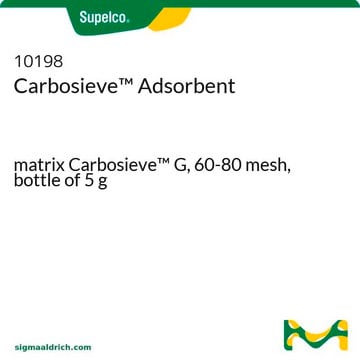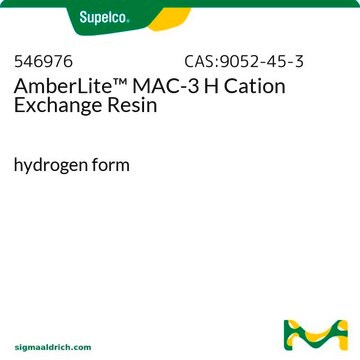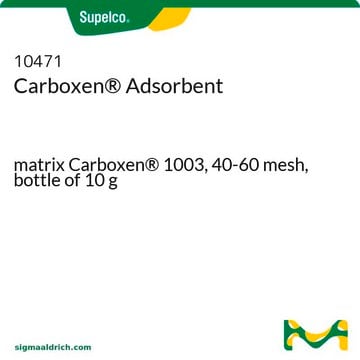10199
Carbosieve Carbon Adsorbent
matrix Carbosieve G, 80-100 mesh, bottle of 5 g
About This Item
Empfohlene Produkte
product name
Carbosieve-Adsorbens, matrix Carbosieve G, 80-100 mesh, bottle of 5 g
Produktlinie
Carbosieve
Form
powder or granules
Verpackung
bottle of 5 g
Methode(n)
LPLC: suitable
gas chromatography (GC): suitable
solid phase extraction (SPE): suitable
Oberflächenbereich
~1160 m2/g
Matrix
Carbosieve G
Aktive Matrixgruppe
carbon
Partikelgröße
80-100 mesh
Porengröße
~0.02 cm3/g mesoporosity
~0.49 cm3/g microporosity
~0 cm3/g macroporosity
~6-15 Å pore diameter
Dichte
~0.27 g/mL (free fall density)
Trenntechnik
reversed phase
Suchen Sie nach ähnlichen Produkten? Aufrufen Leitfaden zum Produktvergleich
Verwandte Kategorien
Allgemeine Beschreibung
- Kugelförmig (bessere Festbettleistung als bei granulären Teilchen)
- Hart und nicht bröckelnd (leicht zu füllen, kein Bruch)
- Hochporös (große Oberflächen)
- Wird für Moleküle mit einer von C2–C5 n-Alkanen abhängigen Analytgröße verwendet
- Hydrophob (können in Umgebungen mit hoher Luftfeuchtigkeit eingesetzt werden)
CMS-Adsorbentien bieten generell eine relative höhere Adsorptionskraft als perlförmige Adsorbentien aus graphitisierter Polymerkohle (SGPC) und graphitisiertem Kohlenschwarz (GCB). Unsere Carbosieve-Produkte sind eine Art von CMS-Adsorbentien.
- Keine konischen Poren
- Sehr hohe Adsorptionskraft, da nur Mikroporen vorhanden sind
- Erstklassige Leistung bei vielen kleinen, flüchtigen Analyten, die von den meisten anderen Adsorbentien nur schwer zurückgehalten werden
Weitere Informationen über unsere speziellen Kohlenstoffadsorbentien finden Sie auf ww.sigma-aldrich.com/carbon
Rechtliche Hinweise
Lagerklassenschlüssel
11 - Combustible Solids
WGK
nwg
Flammpunkt (°F)
Not applicable
Flammpunkt (°C)
Not applicable
Persönliche Schutzausrüstung
Eyeshields, Gloves, type P3 (EN 143) respirator cartridges
Choose from one of the most recent versions:
Analysenzertifikate (COA)
Sorry, we don't have COAs for this product available online at this time.
If you need assistance, please contact Kundensupport
Besitzen Sie dieses Produkt bereits?
In der Dokumentenbibliothek finden Sie die Dokumentation zu den Produkten, die Sie kürzlich erworben haben.
Unser Team von Wissenschaftlern verfügt über Erfahrung in allen Forschungsbereichen einschließlich Life Science, Materialwissenschaften, chemischer Synthese, Chromatographie, Analytik und vielen mehr..
Setzen Sie sich mit dem technischen Dienst in Verbindung.






